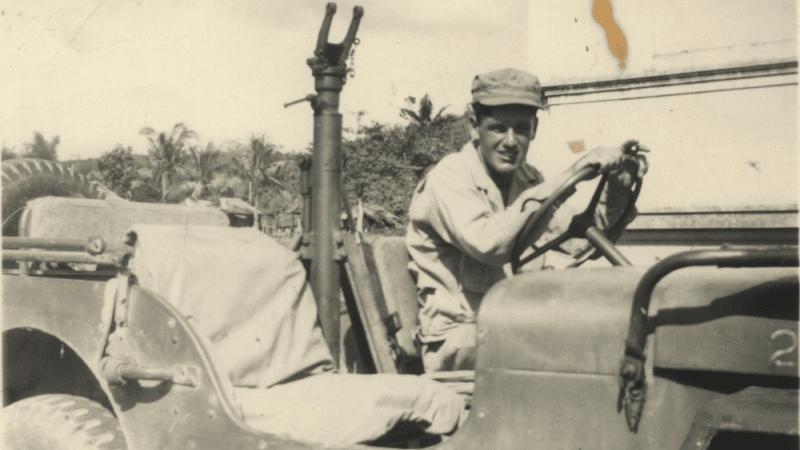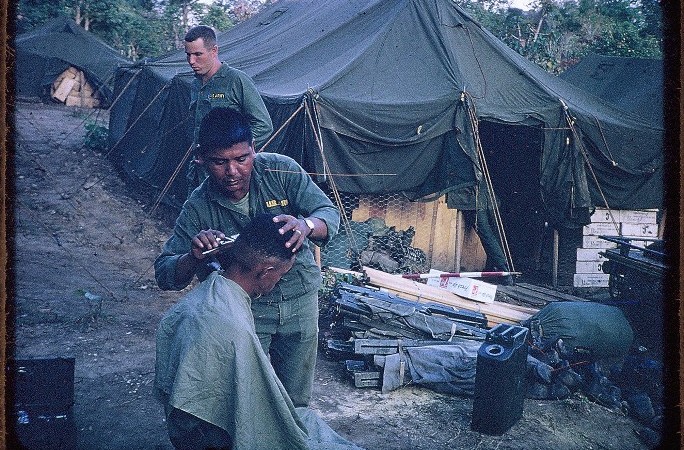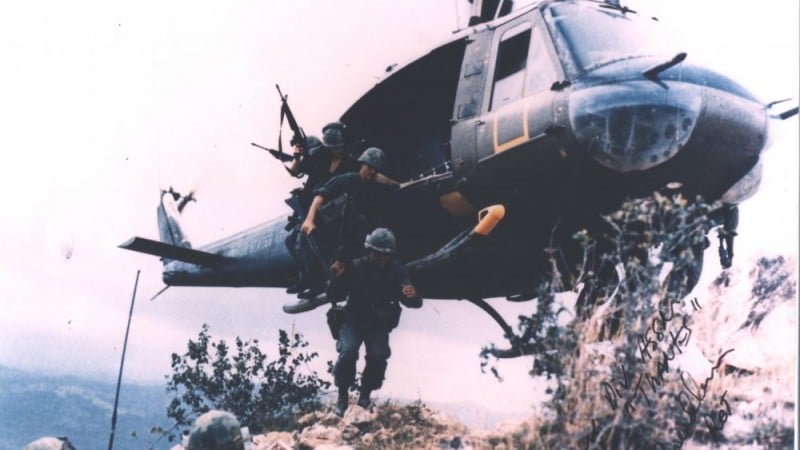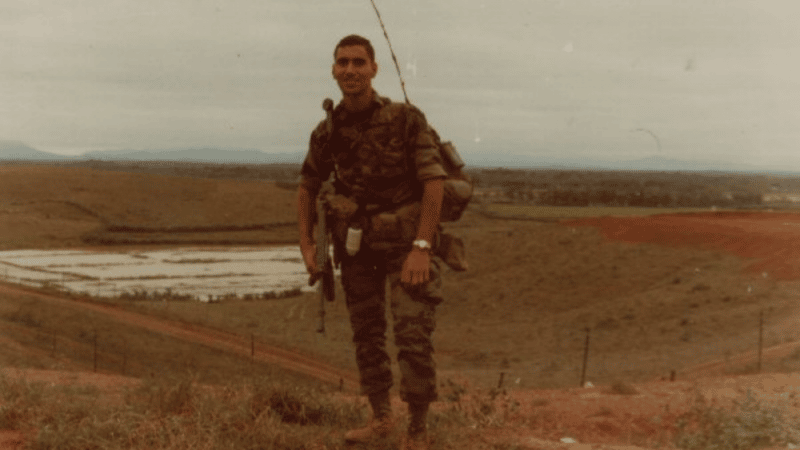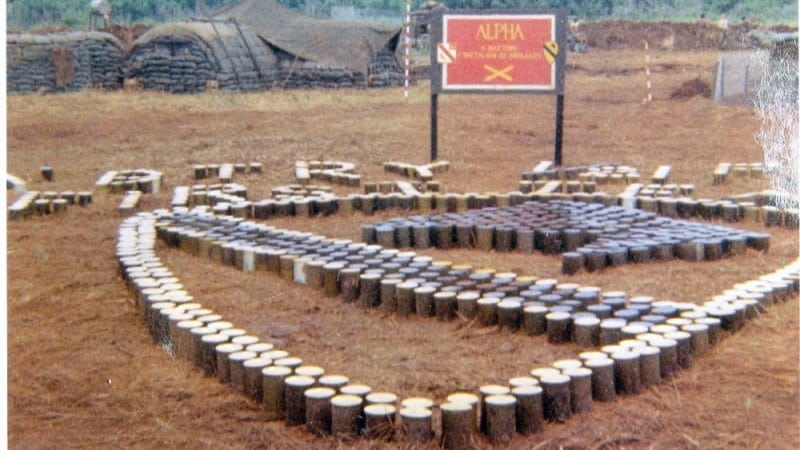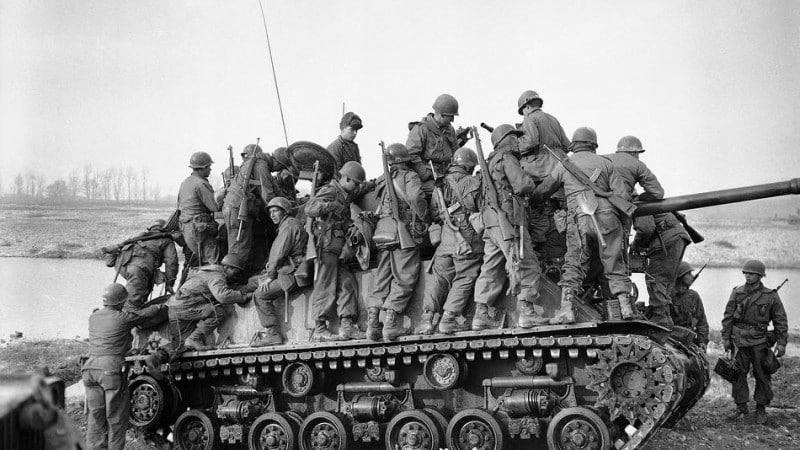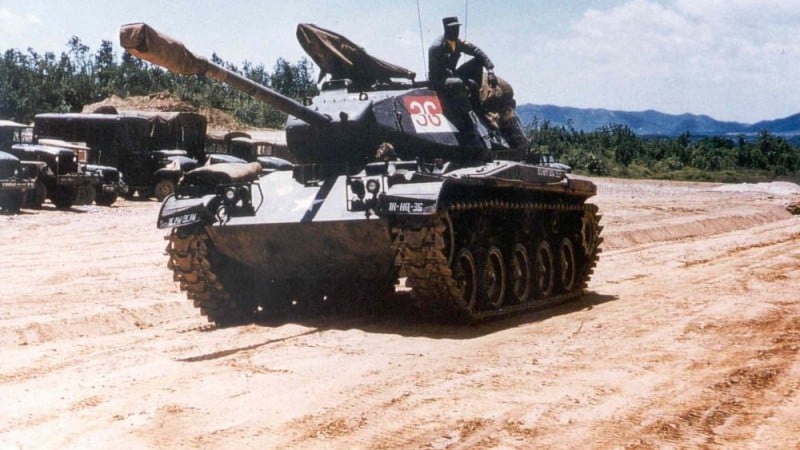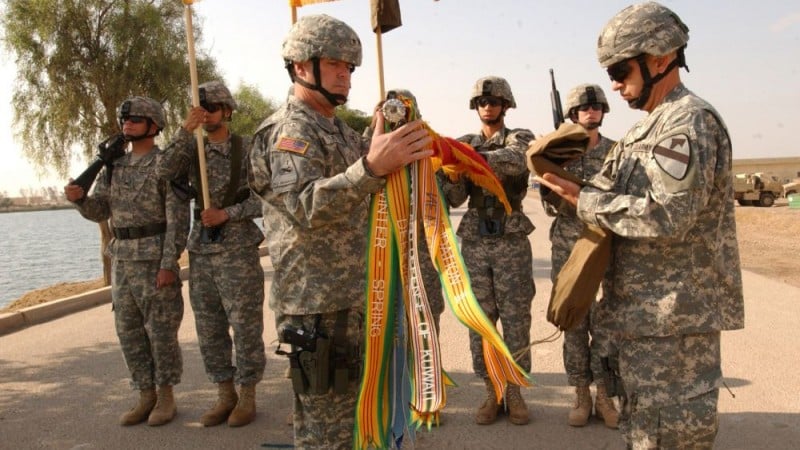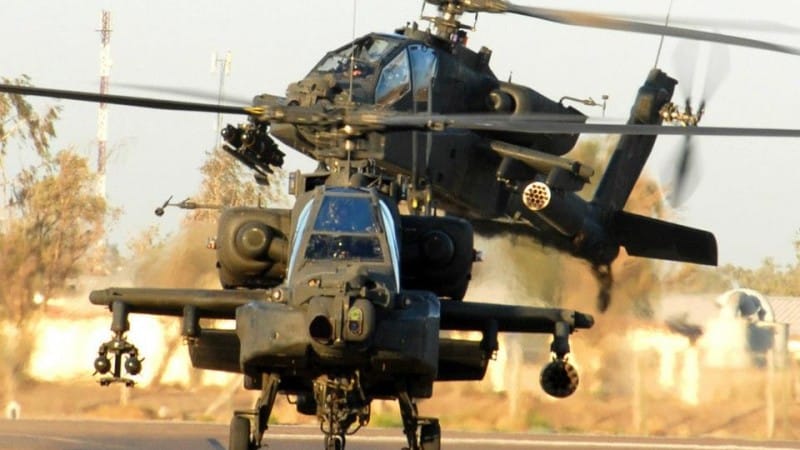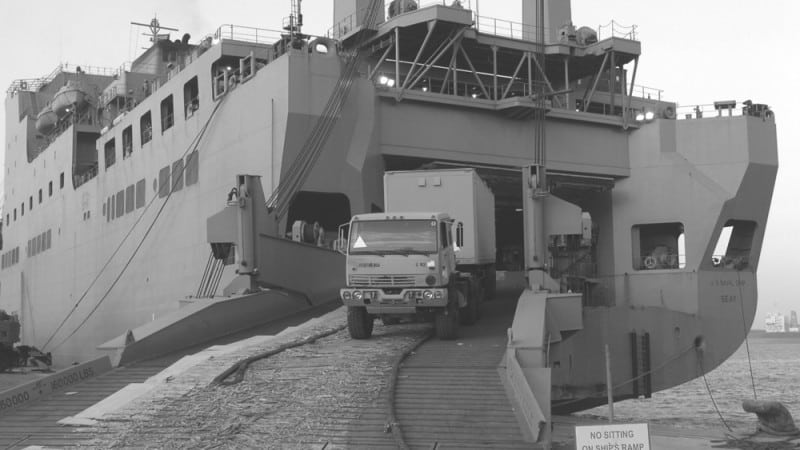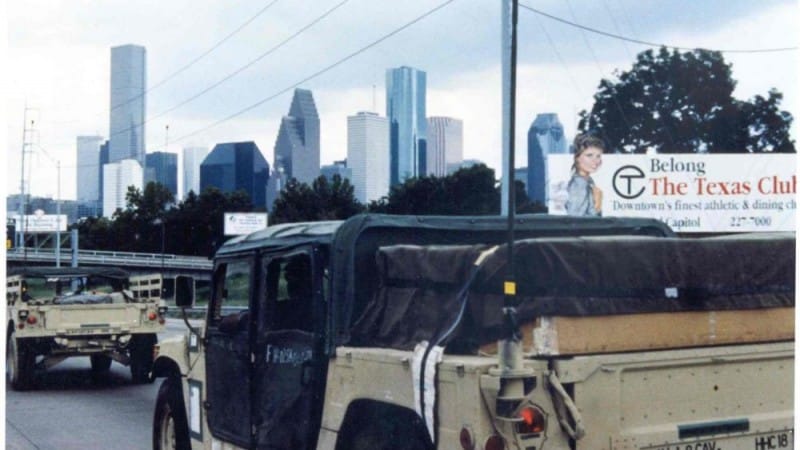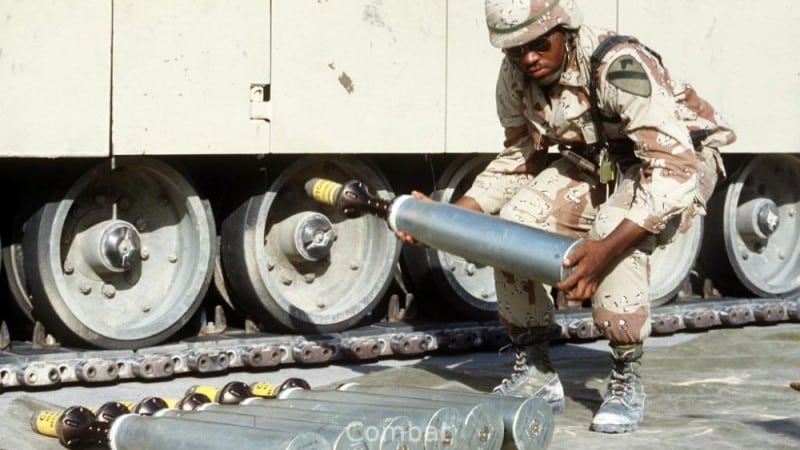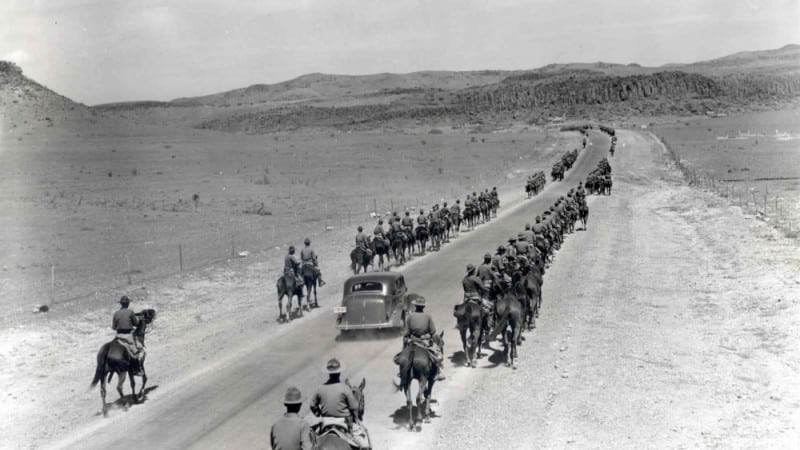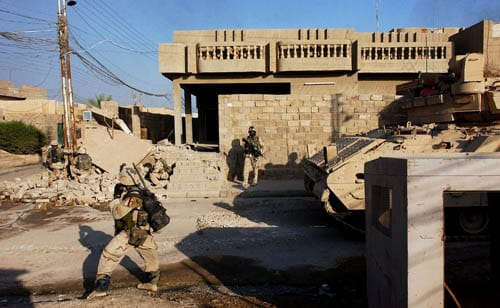227th Aviation Regiment
POUVOIR (Can Do)
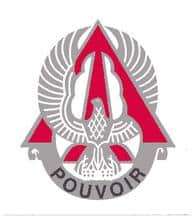
On 1 February 1963, the 31st Transportation Company was redesignated as the 227th Assault Helicopter Battalion and assigned to the 11th Air Assault Division. Starting on the 11th and ending on the 18th of July 1963, the Battalion was activated at Fort Benning, Georgia. In the next two years, through intensive training, its operational capability was enhanced, along with the modernization of fleet equipment.
On 01 July 1965, the units of the 11th Air Assault Division (Test) and the 2nd Infantry Division at Fort Benning, Georgia were reorganized and redesignated as the 1st Cavalry Division (Airmobile).
Within 90 days of becoming the Army’s first air mobile division, the First Team, was back in combat as the first fully committed division of the Vietnam War. An advance party, on board C-124s and C-130s, arrived at Nha Trang between the 19th and 27th of August 1965. They joined with advance liaison forces and established a temporary base camp near An Khe, 36 miles inland from the coastal city of Qui Nhon. The remainder of the 1st Cavalry Division arrived by ship, landing at the harbor of Qui Nhon on the 12th and 13th of September, the 44th anniversary of the 1st Cavalry Division. In the Oriental calendar year of the “Horse”, mounted Soldiers had returned to war wearing the famous and feared patch of the First Cavalry Division. The First Team had entered its third war – and the longest tour of duty in combat history.
Located in the Central Highlands of South Vietnam, An Khe was a small village on the banks of the Song Be River. In the summer of 1965, the villagers acquired thousands of men as new neighbors. They moved in and selecting a relatively flat piece of terrain just north of the village on the eastern lower slopes of Hon Cong Mountain, they set about building the home for the First Cavalry Division (Airmobile). The installation, Camp Radcliffe, was officially named after the Division’s first casualty in Vietnam, Major Donald G. Radcliffe, operations officer for the 1st Squadron, 9th Cavalry. The base got its nickname – The “Golf Course” – when the assistant division commander told his men they were going to create an airbase without the use of heavy machinery because the earth moving equipment would strip the scene of its natural vegetation cover and, with over 400 helicopters on the way, the base would soon become a giant dust bowl or a huge muddy quagmire.
Meanwhile back in the states, the 1st Cavalry Division was feverishly preparing for deployment. The movement of 400 aircraft, 16,000 personnel and 400 vehicles along with the training for combat in just six weeks was an enormous task. (Author’s note: Almost exactly 25 years later this feat would be repeated for the Gulf War in less than four weeks.)
The USS Boxer and three Military Sea Transportation Service Ships had been designated to move the division. All aircraft had to be protected, using preservative techniques. One tends to forget about the strategic mobility problems in moving such a force as the 1st Cavalry Division around the world. Approximately 80,000 man hours were required to process all the aircraft aboard the four vessels. There was a total of 239 aircraft on the Boxer broken down as follows: fifty seven Chinooks (CH-47s), four Flying Cranes (CH-54s), six Mohawks (OV-1s), fifty UH-1s, and one hundred twenty-two OH-13s. The Boxer proceeded via the Suez Canal and the other three smaller vessels traveled through the Pacific via the Panama Canal.
When the ships of the main body arrived in Qui Nhon, the aircraft were prepared for flight on board the carriers. The Chinooks quickly became the prime movers for troops and equipment between Qui Nhon and An Khe. On 28 September, members of the advanced party of the 1st Cavalry assumed responsibility for their own security. By 03 October, the last elements of the Division reached An Khe and the Division was assigned a tactical area which quickly grew to a zone approximately 150 by 150 miles. The establishment of An Khe as the “hub of the wheel” for the early 1st Cavalry Division operations was done for several reasons, not the least of which was aircraft maintenance requirements.
The 227th (AHB), along with the 228th (ASHB), 229th (AHB) and the 11th General Support Aviation Company operated under the command of the 11th Aviation Group. Initially the Assault Helicopter Battalions (AHB) had three companies, “A”, “B” and “C”, of twenty UH-1D helicopters plus one Aerial Weapons Company, “D”, with twelve UH-1B helicopters armed with XM-16 kits (fourteen 2.75″ rockets and four 7.62 mm machine guns. “D” Company flew support for the other three companies, as well as special missions, such as “Nighthawk”. Later in the war, the -1D helicopters were replaced with model -1Hs and the weapons company was upgraded to AH-1G Huey Cobras which carried a mixed armament of XM-157 or XM-159 rockets, XM-18 gun pods and XM-28 minigun and 40 mm in the chin turret. The effective range was about 100 miles, roughly the same as the division “front”. In most part, the 227th supported the 3rd Brigade and the 229th supported the 1st Brigade and both battalions were assigned the responsibility of supporting the 2nd Brigade.
Throughout such operations as the Pleiku Campaign, Nathan Hale, Paul Revere, Thayer and Byrd, the 227th proved that air mobility was a vital factor in the success of the 1st Cavalry Division in Vietnam. In the fall of 1965, the battalion participated in the Pleiku Campaign, airlifting troops into the rugged province near Cambodia, often in the face of heavy enemy resistance. During the campaign, the 227th airlifted the equivalent of 65 infantry companies, flying a total of 6,066 sorties. With the rest of the division, the battalion received a Presidential Unit Citation for this campaign. Throughout 1965 and 1966, the battalion provided integral support and transportation for the division, developing new techniques to meet the challenging battle and weather conditions in the Republic of Vietnam.
From October 1966 into February 1967, the 227th Aviation Battalion supported the operations of the 1st Cavalry Division as it cleared Binh Dinh Province in Operations Thayer II and Pershing, the latter concentrated in the rich northern coastal plain as well as the Kim Son and Luoi Ci Valleys to the west. Operation Pershing presented new problems to the airmobile division as it rooted out the enemy from Binh Dinh Province. The mountainous terrain surrounding the plain, with its inherent clouds and heavy rainfall, made low level, contour flying through the valleys a necessity. Ceiling and visibility were often reduced to zero, zero. Throughout the rest of 1967, the division fought the North Vietnamese Army’s 610th Division and Viet Cong Units in the II Corps Tactical Zone. There were over 7,100 known enemy casualties in the two operations.
Moving to I Corps, Vietnam’s northern most tactical zone, the division set up Camp Evans for their base camp. On January 31 1968, amid the celebration of the Vietnamese New Year, the enemy launched the Tet Offensive, a major effort to overrun South Vietnam. Some 7,000 enemy, well equipped, crack NVA regulars blasted their way into the imperial city of Hue, overpowering all but a few pockets of resistance held by ARVN troops and the US Marines. Within 24 hours, the invaders were joined by 7,000 NVA reinforcements.
It was during the battle for Hue that CWO Frederick E. Ferguson distinguished himself while serving with “C” Company, 227th Aviation Battalion. CWO Ferguson, commander of a resupply helicopter monitoring an emergency call from wounded passengers and crewmen of a downed helicopter under heavy attack within the enemy controlled city of Hue, unhesitatingly volunteered to attempt evacuation. Despite warnings from all aircraft to stay clear of the area due to heavy antiaircraft fire, CWO Ferguson began a low-level flight at maximum airspeed along the Perfume River toward the tiny, isolated South Vietnamese Army compound in which the crash survivors had taken refuge. Coolly and skillfully maintaining his course in the face of intense, short range fire from enemy occupied buildings and boats, he displayed superior flying skill and tenacity of purpose by landing his aircraft in an extremely confined area in a blinding dust cloud under heavy mortar and small-arms fire. Although the helicopter was severely damaged by mortar fragments during the loading of the wounded, CWO Ferguson disregarded the damage and, taking off through the continuing hail of mortar fire, he flew his crippled aircraft on the return route through the rain of fire that he had experienced earlier and safely returned his wounded passengers to friendly control. The extraordinary determination of CWO Ferguson saved the lives of 5 of his comrades. His actions were in the highest traditions of the military service and reflect great credit on himself and the US Army.
Almost simultaneously to the North of Hue, five battalions of North Vietnamese and Viet Cong attacked Quang Tri City, the capital of Vietnam’s northern province. The Cavalry went on the move with four companies of skytroopers from the 1st Battalions of the 5th and 12th Cavalry who arrived at the village of Thorn An Thai, just east of Quang Tri. Under heavy aerial rocket attack, the enemy quickly broke off the Quang Tri attack, dispersed into small groups and attempted to escape. Quang Tri was liberated within 10 days.
Following fierce fighting at Thorn La Chu, the 3rd Brigade moved toward embattled city of Hue. The southwest wall of the city was soon taken after the 1st Battalion, 7th Cavalry overcome severe resistance and linked up with the 5th Battalion. At this point, the NVA and Viet Cong invaders were driven from Hue by late February. The Tet offensive was over. The NVA and Viet Cong had suffered a massive defeat, with 32,000 killed in action and 5,800 captured.
On 19 April 1968, Operation Delaware began. The Viet Cong, who had always considered A Shau Valley to be their personal real estate and a symbol of their relative invulnerability, was about to be given a psychological blow to discover that they had no place in Vietnam where a secure sanctuary could be established. Operation Delaware was a coordinated airmobile and ground attack using elements of three divisions – the 1st Cavalry, the 101st Airborne and the 1st Army of the Republic of Vietnam. The following are excerpts from After Action Reports of the 227th Aviation Battalion.
On 19 April 1968, the 227th Assault Helicopter Battalion, commanded by LTC W.F. Dixon was prepared to commit its maximum available resources in the third massive heliborne assault within a month, Operation/Delaware/Lam Son 216. The plan of operation was to simultaneously assault into the A Shau Valley and to insert a Long Range Reconnaissance Patrol to secure “Signal Hill,” a 4,879 foot peak 5 kilometers northeast of A Loui Airfield to be used as a vital communications relay station. At 0730 hours, 19 April 1968, the weather, which was to play a harassing part throughout the 29 day operation, was a thin overcast on the plains and solid overcast above the valley floor. The cloud tops, however, were at about 4,500 feet. The top of Signal Hill was above the clouds.
With the main assault aircraft on a temporary weather hold, “B” Company, 227th AHB, with four UH-1H helicopters, a command and control ship, and two escort gunships from “D” Company were suddenly in the position of the lead assault element. Carrying an aircraft load of 5, the four lift aircraft departed Camp Evans, climbed through the thin overcast, and were vectored to the initial landing zone. It was briefed to be a single ship LZ and intelligence reports had spotted anti-aircraft positions along the ridge to the northeast and a heavy concentration of assorted weapons in the valley floor to the west. The initial approach was attempted directly to the west, approaching the hill mass at a 45 degree angle. The first view of the LZ showed it to be a bomb crater on a 40 degree slope surrounded by 50 foot trees. Touchdown was impossible and the LRRP’s would have to be rappelled from about 30 feet. The lead aircraft was unable to maintain a position over the LZ and made a “go around.” The second aircraft attempting the drop, lost power and crashed into the LZ, sliding down the hill into the trees. The approach axis was shifted from west to east and the lead aircraft on a second approach successfully rappelled his load and extracted a miraculously uninjured crew of the downed aircraft. A total of 14 sorties were lifted into Signal Hill without further incident with constant improvement being made on the LZ. From the initial assault it looked like a milk run, as no significant anti-aircraft fire was encountered.
During the day, the 227th A.B. had lost two aircraft that were not recovered and over 75% of the fleet had required maintenance. Maintenance crews worked throughout the night to prepare for further lifts the next day. On 20 April, the second day of the assault into the A Shau began with an aircraft hold due to a low overcast and fog on the valley floor. At approximately 0900 Major Burkhalter led “C” Company’s yellow flight followed by “A” Company’s white flight to assault a ridge line 4 kilometers southwest of LZ Tiger to establish a third fire base, LZ Pepper. The approach was made from the north along the ridge into a slope studded with stumps. Again the aircraft could not touchdown and experienced power loss at a hover. The lead aircraft crashed, but all crew and passengers escaped with only minor injuries. The crash, however, closed the LZ until members of 2/9th Cavalry rappelled with chain saws to expand the LZ. Upon resumption of the lift, the new lead aircraft came too close to the trees on takeoff and also crashed. Again the crew got out unhurt. These two crews remained on Pepper for two nights due to bad weather restricting any further flying into the valley. Only one infantry company was airlifted into LZ Pepper before the weather halted all operations.
Bad weather prevailed throughout the entire day of 21 April 1968 with no air assaults being conducted. “D” Company with 6 aircraft was on standby to haul a badly needed resupply to LZ Tiger. Shortly after noon the aircraft took off at 1 minute intervals with an 800 pound sling load under each aircraft. One by one, the aircraft were radar vectored to a point over LZ Tiger. Each aircraft had to feel its way through the holes in the overcast creating a separate approach axis for each. The gambit proved quite effective and a total of 14 sling loads were taken into both Tiger LZ’s before the weather again closed. For most of the crews, it was their first actual instrument flight. 22 April brought much improved weather conditions and the air lift into LZ Pepper continued with a maximum of aircraft again committed. Anti-aircraft fire was harassing but far less than previous days. At the day’s end the 3rd Brigade was firmly entrenched in the A Shau Valley with three Infantry battalions plus supporting artillery.
On 24 April, “A” and “B” Companies, each with six aircraft, joined the 229th AHB to air assault elements of the 1st Brigade into LZ Cecile, 2 kilometers south of A Luoi Airfield. Again weather played a significant part forcing the lifts to climb as high as 11,000 feet to clear the cloud tops. Once over the valley and through the holes in the overcast the aircraft delay-chained to the new LZ, covered a route by the guns of both 227th AHB and 229th AHB, LZ Cecile was a two ship LZ at the southern end of a ridge about 2,200 feet high. Although all aircraft were exposed to sniping fire on the approach, the main threat came from an automatic weapons position about 500 meters down the ridge to the southeast. Since the approach was made to the south, the enemy gunners get crack at each aircraft as it departed no matter which way it broke. Very few hits were sustained and no aircraft were lost as the lift of the 2/8th Cavalry on to LZ Cecile was completed prior to 1400 hours.
Late in the afternoon, “B” Company was given the mission of an emergency re-supply of LZ Cecile. The 2nd Battalion, 8th Cavalry had run short of ammunition and supplies after making contact on the landing zone. A hole was found in the overcast and the six aircraft climbed on top at 6,000 feet. A radar vector was obtained to get out to the valley and the ceiling in the A Shau Valley was forecast at about 800 feet. When the aircraft arrived, a hole was found in the vicinity of LZ Tiger and the ships proceeded in trail from 8,500 feet to 800 feet above the valley floor. The ships low level approach was another story. The flight received heavy automatic weapons fire during the entire traversing of the valley floor. One ship was hit in the engine tail pipe, but remained flyable. The aircraft found a hole to climb through near LZ Tiger and exited the A Shau Valley.
On 28 April, the 227th AHB committed ships to lager during the night at LZ Stallion. The weather had varied between low ceilings and ground fog in the morning to high cumulus clouds in the afternoon. This had seriously restricted the operations because at the time when the valley floor was clear enough for operations, ships could get into the valley due to the high, dense, clouds surrounding the A Shau. The laagered ships could support units in the valley in case the A Shau weather deteriorated to the point that ships could not get in while the floor of the valley allowed airmobile operations.
On 10 May, the extraction phase of Operation Delaware began. The weather, which had been poor throughout the operation, began to deteriorate. “A” Company, 227th AHB was assigned the mission to extract two battalions from the A Shau Valley. The battalions involved were the 1/7th and 5/7th Cavalry. The flight leader had been briefed the day before the move by the ground commanders on the execution of the mission. Twelve lift ships and two gunships were committed the next morning to begin the extraction of the 5/7th. Plans had changed considerably from the briefing that was given the previous day and the flight was to take the entire battalion back to Camp Evans, instead of the airstrip at LZ Stallion and await further orders. About 1200 hours, a company of the 2nd Battalion, 7th Cavalry came into heavy contact about 2 kilometers northwest of LZ Pepper. The flight was to extract the unit back to LZ Pepper. The extraction was accomplished smoothly with the assistance of two gunships from “D” Company, 227th AHB, two fighters and eight ARA rocketships. Once this was completed the flight returned to LZ Stallion to wait for the 1st Battalion, 7th Cavalry to get into a pickup posture. The entire mission for the day was accomplished without incident, with the outstanding support that was given to the lift aircraft by the gunships of “D” Company, 227th AHB.
For the remainder of the extraction place of Operation Delaware, the aircraft of the 227th AHB gave maximum air-support to the ground commanders. The problems encountered by the 227th were only overcome by the sheer determination and true professionalism displayed by all members of the Battalion. Eventually, all of these problems fell on the shoulders of maintenance personnel at Camp Evans. These people worked night and day to repair damages sustained along with normally scheduled maintenance. The maintenance effort was outstanding in keeping the availability of the 227th at a high. By this maximum output and coordination, the 227th was able to help insure the success of Operation Delaware/Lam Son.
In the fall of 1968 the battalion moved south to the new area of operations, the III Corps tactical zone. From this location, the battalion supported the division as it interdicted the enemy infiltration routes from Cambodia. The terrain was thick jungle which frequently concealed machine gun positions of the enemy. Extensive use was made of the battalion’s Nighthawk helicopters in the III Corps areas. The unique installation of an infrared light coupled with a starlight scope, a powerful spotlight, three M-60 machine guns and a mini gun mounted in the rear cabin seriously hampered the enemy’s ability to take advantage of darkness.
Despite the flatness of the terrain of the III Corps area, the 227th found that the heavy tangled vegetation and the dearth of landing zones reduced the size of the basic assault combat flight. In addition, the use of .51 mm anti-aircraft weapons called for a greater reliance on escort Cobra gunships from “D” Company. The typical insertion formation was modified to six Hueys, which carried the infantry, and two gunships from “D” Company. The gunships would make a strafing run, covering areas around the landing zone prior to troop landings. The Cobras would also circle the landing zone as troops landed, discouraging the enemy from firing on the Hueys at that most vulnerable moment.
Throughout 1969, the battalion continued to support the division by providing rapid, flexible assault transportation to any terrain, the key to the continued mobility of the 1st Cavalry Division.
On 05 May 1971, the colors of the 1st Cavalry Division, minus those of the 3rd Brigade, were moved from Vietnam to Ft. Hood, Texas. Using the assets of the 1st Armored Division, the 1st Cavalry Division was reorganized, reassigned to III Corps and received an experimental designation as the Triple-Capability (TRICAP) Division. Its mission, under the direction of Modern Army Selected Systems Test, Evaluation and Review (MASSTER) was to carry on a close identification with and test forward looking combined armor, air cavalry and airmobile concepts.
On 30 August 1971, “D” Company, 227th Aviation Battalion was inactivated in Vietnam; reactivated and assigned as “D” Troop, 9th (Air) Cavalry Brigade (Prov), who had been assigned to the 12th Aviation Group previously on 10 April, 1971.
The main body of the 1st Cavalry Division, at Fort Hood, under the direction of MASSTER, continued to test future concepts of mobility and flexibility on the battlefield. The tests continued for three and a half years were very demanding. It was concluded that the employment of the TRICAP concept at the battalion level appeared to have application in some tactical situations, but employment at company level appeared to be feasible only for short periods of combat and for special missions. Evaluation also indicated that air cavalry would normally be controlled above the company level. The battalion task force encountered no combat support problems directly attributable to the TRICAP concept.
On 5 May 1974, seeing a continuing need for aviation assets to support its combat role, a 1st Cavalry Division Aviation Brigade (Provisional) was formed. Somewhat in parallel, the 227th Aviation Battalion continued their role of Division support until 19 November, 1974 when its Headquarters and Headquarters Company was reorganized and redesignated as the 227th Aviation Company. The organic elements were concurrently inactivated. In its new role, the 227th Aviation Company performed its mission of supporting the 1st Cavalry Division.
On 21 February 1975, the end of TRICAP evaluations, the mission of airmobile anti-armor warfare was transferred to the 6th Cavalry Brigade (Air Combat) co-located at Fort Hood, Texas and the 1st Cavalry Division was reorganized and redesignated to become the newest Armored Division in the Army, essentially the battle configuration it retains until the Divisional Modular Reorganization that it retains today.
On 8 August 1977, in the continuing wrestling with the role of divisional aviation assets, the 1st Squadron, 9th Cavalry Regiment, 19th Combat and the General Support Aviation Companies were assigned to the Aviation Brigade, filling out its organizational needs. This change was augmented on 21 May, 1978 when the 227th Aviation Company was reorganized and designated the 1st Battalion, 227th Aviation with organic elements concurrently activated.
These two aviation assets, the 1st Battalion, 227th Aviation Regiment and the Provisional Aviation Brigade, continued concept testing and Divisional operational support until 1 September 1984, when the provisional status of the Division Aviation Brigade was removed and the unit was official activated and assigned to the 1st Cavalry Division. Concurrently the 1st Battalion, 227th Aviation Regiment was assigned to the Aviation Brigade. By then, the 1st Battalion had been filled out with the following companies:”HHC”, 1st Battalion, 227th Avn Rgt; “A” Co, 1st Battalion, 227th Avn Rgt; “B” Co, 1st Battalion, 227th Avn Rgt; “C” Co, 1st Battalion, 227th Avn Rgt; “D” Co, 1st Battalion, 227th Avn Rgt; “E” Co, 1st Battalion, 227th Avn Rgt; and “F” Co, 1st Battalion, 227th Avn Rgt.
This effective build-up and training of aviation capabilities could have not come at a more opportune time in the history of the First Team. On 7 August 1990, a deployment order for the Southwest Asia operations was issued. Plans calling for the Division to deploy by 15 September extended the work day to 14, 16 and in some cases 24 hours. On schedule, by mid September heavily loaded vehicles and aircraft were loaded at the Fort Hood railhead to make the trip to the seaports of Houston and Beaumont. Additional vehicles formed road conveys that left every two hours, around the clock.
The First Team Soldiers flew from Robert Gray Army Airfield to Dhahran International Airport via Paris, France and Cairo, Egypt. There, they settled into warehouses and tents to await the arrival of their equipment. As soon as their equipment arrived, they moved to the remote Assembly Area Horse (AA Horse) in the Saudi desert 160 miles west of the airport.
Between 30 September and 10 October, the 227th Aviation Regiment off loaded equipment at the Port of Ad Dammam, Saudi Arabia and prepared for operations. On 10 October, the 1st Battalion moved 165 km Southwest into the desert and deployed to Assemble Area, “Horse”. On 30 October, the Battalion began familiarization and crew training to adjust to the Saudi Arabian desert environment. Special emphasis was placed on night proficiency. Flight training continued into November, changing emphasis to team and company drills. Plans and rehearsals for the defense of Saudi Arabia were developed and constantly refined.
Running fire drills, allowing Apaches to stay low during engagement without producing high dust signatures were practiced. These techniques were practiced and refined during company battle drills day and night. During the first week of January, AH-64 live fire, night gunnery was practiced on the Pegasus Range, which had been built up out of the desert sands by the 8th Engineer Battalion.
On 11 January 1991, beginning to focus on offensive action, the 1st Battalion moved northwest to Tactical Assembly Area Wendy, located in the vicinity of King Khalid Military City (KKMC). For the 1st Battalion, the war began during the day, on 17 January, in an attack against 50 Iraqi tanks crossing the border into Saudi Arabia. Shortly after departure, the mission was scrubbed without any direct engagement. The Iraqi tanks had defected. Positioned at Assembly Area Wendy, plans for the defense of Wadi al Batin and areas north of Tapline Road were refined. In further preparation, on 04 February, Hellfire gunnery was conducted at night on the Jayhawk Range.
On 10 February, the 1st Battalion moved North of Hafar al Batin to Assembly Area Bart. Although plans had been made to conduct screen operations, none were flown as part of the 1st Cavalry Division’s plan of deception to conduct a “feint” attack up the Wadi al Batin, creating the illusion that it was the Allies main ground attack. Crew chiefs went to work by flashlight to ready the helicopters that would fly into killing range of the Iraqi 27th and 28th Infantry Divisions. After being postponed three times, the Battalion launched early in the damp, cold dawn of 25 February without close air support. The mission was composed of sixteen AH-64’s to concentrate fire power on the prime target areas.
Passing over the berm and over the 2nd Brigade, the pilots could make out tankers below waving and cheering the “tank killers” on. Moments later, eight Iraqi Soldiers held up tattered white flags. Bravo Company’s “Grim Reaper” scouts landed their OH-58’s to watch them until members of the 2nd Brigade could round them up and collect them. Meanwhile, the Battalion was hitting the enemy hard, destroying tanks, trucks, mortar and artillery pieces, fuel tankers and Soldiers.
As the fire escalated, a radio call froze everyone for an instant. “We’re hit, we’re hit, we’re going down”. It was the Commander of Charlie Company, Captain Mike Klingele. Their wingman, 1st Lt. Robert Johnston, saw the crash and suppressed the enemy who had already begun to move in on the wreck. Captain Klingele and his crewman CWO Mike Butler were able to free themselves from the cockpit and began to run towards Johnston’s ship. Johnston took off with the two hanging by a strap attached to the pylons. The Iraqis, fearing the main effort was about to be launched, set fire trenches ablaze in front of the 2nd Brigade. The smoke, combined with the uncertain tactical situation, made a recovery of the AH-64 by a CH-47 Chinook too risky. The downed helicopter was destroyed in place with two TOW missiles.
The Battalion regrouped and made two more runs against the Iraqis before they were relieved by the 1st Battalion, 3rd Aviation Regiment. The tally for the day was thirty one bunkers, one tank, three howitzers, five trucks, a radar site and two grateful survivors.
On 27 February, the Battalion moved North across the Saudi Arabia – Iraq border as an element of the ground war. Aircraft stopped to refuel at Objective Lee, then continued Northeast in Iraq to Assembly Area John. Upon arrival the aircraft remained in standby and were not committed to battle. On 28 February, the ground elements of the 227th closed with the aircraft when the 48 hour cease fire went into effect. As the sun rose over the silent battlefield, the Aviation Brigade found itself squarely in the middle of the Tawakalna’s former sector. The sand was laced with unexploded cluster munitions from the intense air campaign against the Republican Guard.
On the opening days of the ground war, 24 – 25 February, the Blackjack Brigade, supported by the Aviation Brigade Apache helicopters, in Operation QUICK STRIKE, moved into Iraq on a “reconnaissance in force”. The 3rd Battalion, 82nd Field Artillery, reinforced by Battery “A”, 21st Field Artillery Multiple Launched Rocket Systems (MLRS) laid down heavy fire in support of the 2nd “Blackjack” Brigade’s “feint” attack up the Wadi al Batin. The Blackjack Brigade broke contact after penetrating enemy obstacles, taking fire and causing the enemy to light oil fire trenches. They withdrew south to rejoin the division for the subsequent series of final attacks.
The enemy reacted as anticipated. Iraqi divisions focused on the coalition threat in the Wadi, and the First Team froze them. The deception worked, in that it tied down four Iraqi divisions, leaving their flanks thinned and allowed the VII Corps to attack virtually unopposed, conducting a successful envelopment of Iraqi forces to the west.
Having fulfilled their assigned mission of deception, the following day, General Norman Schwarzkopf issued the command “Send in the First Team. Destroy the Republican Guard. Let’s go home”.
On 04 March, a thorough battle assessment was conducted. As part of the cleanup operations, two OH-58’s, equipped with loud speakers, along with AH-64 helicopters swept a large area of Southern Iraq evaluating battle damage using gun cameras to record the wreckage. The mission also uncovered several Iraqi Soldiers left behind in the retreat of the Republican guard. On 07 March, fourteen of the personnel of the Battalion, led by the Battalion XO, departed with the advance party of the Division to Fort Hood, Texas.
On 9 and 10 March, searching through the historic Euphrates River Valley, the Aviation Regiment supported demolition operations of abandoned equipment and undamaged Iraqi equipment. Within 2 weeks, the 1st Cavalry moved south into Saudi Arabia and the new assembly area (AA) Killeen. There on the plain of the Wadi al Batin – the Cavalry began to prepare for redeployment home.
Upon return to the United States, The first of a series of reorganizations were initiated in the period May 1991 to August 1993, which resulted in a contingency force, ready to deploy anywhere in the world on a moment’s notice. On 6 November 1992; Company “D”, 227th Aviation Regiment was redesignated as 4th Battalion, 227th Aviation Regiment (Provisional). On 16 December 1993, the Provisional status was removed by its activation and assignment to the 1st Cavalry Division. More recently, on 27 June 1997, as part of the restructuring of the Aviation Brigade, the 4th Battalion was redesignated as 2nd Battalion, 227th Aviation Regiment.
On 2 June 1998, after years of testing and preparation, the 1st Battalion, 227th Aviation Regiment began to field the most advanced attack helicopter ever built, the AH-64D “Longbow”. Just as the English longbow archers provided a great advantage during medieval battles, the integrated cockpit instrumentation displays and target sensors provide the AH-64D Apache Longbow pilots an overwhelming extended target capability advantage on the digital battlefields of the 21st Century.
The heart of the weapon system of the Longbow is the new millimeter wave radar that can track up to 256 targets simultaneously, along with a new generation of radar guided Hellfire anti-tank missiles with fire-and-forget capability. The Longbow has the capability to pass its targeting information to others to enable coordinated attacks with unprecedented precision, lethality, and speed, all with minimal exposure to enemy fire.
The first of the upgraded Block II Apaches was delivered to the US Army in February 2003. Block II includes upgrades to the digital communications systems to improve communications within the “tactical internet”.
Block III improvements, slated for 2008 onwards, include increasing digitization, the joint tactical radio system, enhanced engines and drive systems, capability to control UAVs, new composite rotor blade and landing gear upgrades. The new blades, which successfully completed flight testing in May 2004, increase the Apache’s cruise speed, climb rate and payload capability. The Block III System Development and Demonstration (SDD) contract was awarded to Boeing in July 2006.
On 7 January, the reality of the “Digital Battlefield” loomed on the horizon as elements of the 1st Cavalry Division, the 1st Battalion, 227th Aviation Regiment, 68th Chemical Company and supporting detachments (slice) of the 615th Aviation Support Battalion and 1st Battalion, 21st Field Artillery Regiment received orders to prepare for deployment to Southwest Asia, under the control of US Central Command, Tampa, FL. The 1st Battalion, 227th Aviation, one of the first units to be equipped with the AH-64D Apache Longbow Attack Helicopters, has the primary mission to seek out and destroy enemy armored vehicles. After moving the equipment of the battalion to port over the weekend of 18 January, the two main bodies of the 1st Battalion departed on charted aircraft to Kuwait on 12 & 16 February.
On 14 February the lead body of the 1st Battalion, 227th Aviation Regiment arrived in theater and closed on Camp Udari, a built up airfield in the northwest portion of the Kuwait desert, near the Iraq border, and was attached to Task Force 11th Aviation operating under the command of the US Army V Corps.
The 1st Battalion, 227th Aviation aircraft and equipment, leaving the Port of Houston on 22 January arrived in Kuwait on 25 February was downloaded within two days (faster than any other unit in theater), inspected and convoyed in four hours to Camp Udari. Once all equipment was in place, a key set of Reception, Staging, Onward Movement and Integration (ROSI) events were executed as the battalion was integrated into the 11th Aviation Regiment (AHR). Primary exercises carried out were Night Vision Goggle (NVG) driver’s training, Longbow hellfire missile, 30mm, rocket firing at the Udairi range, and Military Decision Making Processes (MDMP) planning.
The first action, in preparation of Operation Iraqi Freedom (OIF-1), began by crossing the Kuwait/Iraq International Border and executing a 500 kilometer (300 miles) tactical roadmarch, mostly over open desert, to establish the 11th Aviation Regiment Forward Arming and Refueling Point (FARP) at Objective RAMS. This movement was made in four stages:
The first stage, on 18 February, Task Force (TF) III/V departed Udairi, conducted a link-up with the 2nd Brigade Combat Team, 3rd Infantry Division (Mechanized) and, on 19 February at approximately 1400 hours (local), crossed the international border. TF III/V completed its movement and occupied Objective RAMS on 23 March at approximately 1300 hours (local).
In the second phase, the quartering, or advanced party departed Camp Udairi on 18 March at 0800 hours (local), and arrived at Objective RAMS on 23 March at approximately 0500 hours (local).
In the third phase, the main body departed Camp Udairi on 19 March at 0700 hours (local) and occupied Objective RAMS on 24 March at approximately 1900 hours (local).
Finally, the battalion trail party departed Camp Udairi on 23 March at 0700 hours (local) and closed on Objective RAMS on 26 March at approximately 1400 hours (local).
At the on-set of hostilities, the battalion had 375 personnel present in theater, with 18 AH-64D Longbows, and 72 ground prime movers. The first tactical mission planned as an attack on the 11th Infantry Division in the vicinity of (IVO) An Nasirya near Tallil Airfield, Iraq was not executed due to low ceilings experienced enroute by the 6th Squadron, 6th Cavalry Regiment, the lead squadron, approximately 10 kilometers (6 miles) north of Kuwait border. The battalion next postured and planned for a two battalion simultaneous attack to destroy the 2nd Armored Brigade of the Medina Division of the Iraqi Republican Guard in the vicinity of the city of Karbala. The third attack squadron, 2nd Squadron, 6th Cavalry Regiment had a be prepared to (BPT) attack mission in support of the operation.
The 1st Battalion, 227th Aviation Regiment conducted its initial attack on the night of 23 March. The battalion launched the attack from Camp Udairi and refueled at Objective RAMS occupied by TF III/V. After a quick brief conducted by the 6th Squadron, 6th Cavalry Regiment, the battalion took off at 0122 hours (local) on 24 March and fought through arms fire as far south as 25 kilometers (15 Miles) away from the enemy action of a fierce battle with units of Iraq’s Republican elite Medina Division units between the cities of Karbala and al Hillah, about 96 kilometers (60 miles) south of Baghdad.
The attack, started after midnight, lasted about three hours. One of the elements of the opposing force struck was Iraqi T-72 battle tanks, the most advanced tank used by the Iraqi forces. The Republican Guard was estimated to have at least 90 of those tanks, along with “multiple” pieces of field artillery and armored personnel carriers, The Apache unit went up against the 2nd Armored Brigade of the Medina Division, which is part of the Republican Guard, the troops most loyal to Saddam Hussein. Many Apaches were hit by arms fire, but managed to destroy 10 Iraqi tanks before cutting off their attack. They also attacked positions between Karbala and Hillah, which straddle the Euphrates River south of Baghdad.
There were many heroic actions as the battalion reacted to a coordinated air ambush that night. The battalion did, however, have one aircraft shot down with 16 of the remaining 17 aircraft receiving varying amounts of battle damage The aircraft of the battalion met determined Iraqi opposition but were still able to accomplish most of its tasks for the mission. The downed helicopter (99-5135) of “C” Company, 227th Aviation Regiment received a hit which damaged the Flight Management Computer. Losing control, the pilot had to make an emergency landing and come down in a field near Karbala, about 60 miles southwest of Baghdad, close to the site where the fierce predawn battle took place. The attack force had not expected such strong Iraqi resistance from what they thought were mostly civilian populated areas.
During the battle, two attempts to rescue the pilots were aborted due to heavy fire. The next day, al-Jazeera, the Arab world’s TV broadcast in Iraq showed the downed AH-64 helicopter sitting upright on the ground in an open field. From appearances, it did have any external battle damage to indicate that it had been shot down as reported by the al-Jazeera narrator. The helicopter was quickly located by Coalition aircraft and destroyed so that none of the classified electronic on-board systems would be salvaged and examined by any foreign agents.
After their Apache helicopter came down, Chief Warrant Officer David S. Williams and Chief Warrant Officer Ronald D. Young jumped in a canal and swam a quarter-mile but were caught by armed farmers who spotted them in the moonlight when they tried to run for cover in a stand of trees. The villagers beat them with sticks and were threatened at knife point. Afterwards the two men were thrown in the back of a pickup truck and driven around “to show all the other people that they had captured Americans. Originally, the Army classified the two men as “missing in action”, but later in the day, the Iraqi Government showed them on local and national TV channels and announced that the two pilots had been captured and would be treated as prisoners of war.
Through Battle Damage Assessment Reports (BDAR) and outstanding efforts of the battalion maintenance crews, 6 aircraft were flyable within 96 hours, 9 were full mission capable (FMC) 96 hours after that and 12 full mission capable within two weeks. The battalion reconstituted/refit after the mission and returned to full combat power within 30 days. By 25 March, the battalion’s maintenance status had recovered enough from the attack of 23 March for the unit to continue the conduct combat operations in support of V Corps and 11th Aviation Regiment (AHR) as part of the Corps reserve.
The next missions of the battalion, conducted from 04 through 14 April, were Route Security and Reconnaissance in support of the 82nd Airborne Division in the vicinity of As Samawah and north to the Karbala Gap, the 101th Airborne Division, the 2nd Armored Cavalry Regiment, and Reconnaissance and Security of Tactical Assembly Area (TAA) VICKSBURG. These close, decisive operations and netted outstanding results in support of the ground maneuver commander’s plan.
On Palm Sunday, 13 April, as the Marines were closing on Tikrit and nearing Samarra, 58 kilometers (35 miles) south of Kikrit, they were contacted by an Iraqi citizen indicating that they would shortly “come in contact with a number of Americans”. Soon afterwards they were taken to a house were they found the seven missing US POW Soldiers. They appeared to be unharmed and in a healthy condition and were immediately transported to an airfield about 50 miles south of Baghdad in ambulances where all ran or walked, although two of them had gunshot wounds, to a C-130 transport plane to take them to Kuwait. Two walked with a limp and one of those was a woman, One of the seven raised his hand in victory, and the woman was carrying her own equipment. Marines nearby applauded as they passed by them.
The Defense Department did not release the names of those rescued until their Families were notified, but two were identified in a press pool photograph caption as the two Apache helicopter pilots from the 1st Battalion, 227th Aviation Regiment, 1st Cavalry Division, Chief Warrant Officer David S. Williams, 30, of Orlando, FL and Chief Warrant Officer Ronald D. Young Jr., 26, of Lithia Springs, GA, who had made an emergency landing due to a mechanical failure and were captured 24 March during heavy fighting with the 2nd Armored Brigade, Medina Division, Iraqi Republican Guard.
On Saturday, 19 April, the seven former US prisoners of war smiled and waved to a crowd of well-wishers Saturday as they boarded a C-17 in Germany that was carrying them home to their Families in the United States. About 30 well-wishers waving American flags and one bearing a banner that read “Proud of Our Warriors” gathered beside the plane to see the seven off and to wish them a safe journey home. The destination of the trans-Atlantic flight was Ft. Bliss, TX, where five of them were stationed with the US Army’s 507th Maintenance Company. The two other former POWs, Apache helicopter crewmen, with the 227th Aviation Regiment, 1st Cavalry Division, continued to their home base at Ft. Hood, TX.
Upon landing at Ft. Hood, the two crew members of the 1st Battalion, 227th Aviation Regiment were escorted down a red carpet and were met with chants of “Hoo-ah!” from their comrades and to a swarm of overjoyed friends and relatives who exchanged hugs, tears and handshakes with them. The crowd cheered and clapped amid the tumult of a brass band’s military tune of “Garryowen”.
Overall during operations, in support of Operation IRAQI FREEDOM, the 1st Battalion, 227th Attack aircrews flew over 450 combat hours, destroyed over 100 pieces of enemy equipment and an estimated 300 personnel. Additionally, the battalion’s drivers traveled over 2,750 miles conducting convoys, establishing Forward Arming and Refueling Point (FARPs), and logistical functions. On 22 April, as the battalion prepared to move north to Balad Airfield, it received orders to redeploy the battalion back to home station. The1st Battalion, 227th Attack conducted retrograde operations with all assigned personnel and equipment. In total the battalion flew over 680 hrs in theater moving, prepping and executing combat operations. It expended over 100 hellfire missiles (shot or damaged), 800 rockets, and 14,000 30mm rounds while consuming over 100,000 gallons of JP8 fuel. Remarkably, the battalion completed operations in Iraq without a single serious incident or accident, either on the ground or in the air.
On 24 April the battalion began redeployment back to Camp Udairi closing on the redeployment Assembly Area (RAA) on 26 April. On 17 May the battalion began movement to the port in Kuwait and redeployed personnel on Wednesday, 21 May.
On 6 June, the battalion executed a change of command ceremony and is currently updating the Regeneration Plan to bring the battalion’s personnel and equipment back to the highest combat ready status. All equipment was returned to Ft. Hood on 25 and 29 June.
